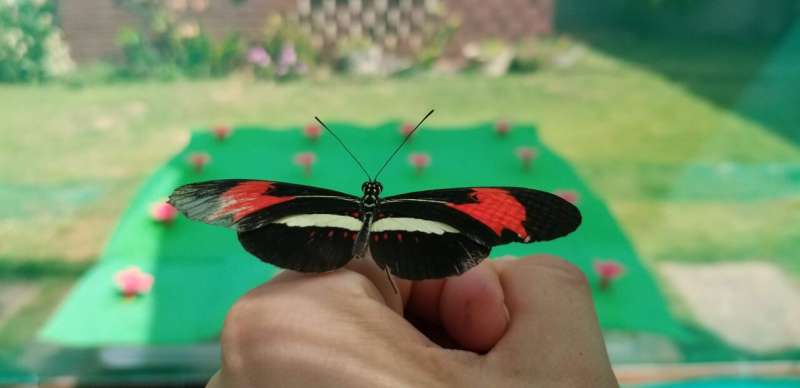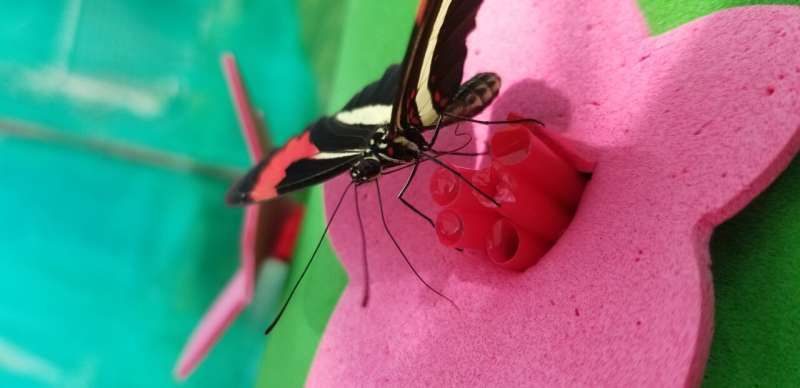This article has been reviewed according to Science X's editorial process and policies. Editors have highlighted the following attributes while ensuring the content's credibility:
fact-checked
peer-reviewed publication
trusted source
proofread
Butterflies can remember where things are over sizeable spaces, new study finds

Heliconius butterflies are capable of spatial learning, scientists have discovered.
The results provide the first experimental evidence of spatial learning in any butterfly or moth species.
The findings, published in Current Biology, also suggest Heliconius butterflies may be able to learn spatial information at large scales, consistent with the apparent importance of long-range spatial learning for traplining, which involves foraging within a home range of a few hundred square meters.
Spatial learning is known in insects, but much of the research has focused on ant and bee species which live socially in a communal nest. This study provides the first direct evidence of spatial learning in butterflies or moths, and suggests that complex learning skills, such as the use of spatial information, may be more common in insects than previously thought.
Dr. Stephen Montgomery of the University of Bristol's School of Biological Sciences, a senior author, explained, "Heliconius butterflies have evolved a novel foraging behavior among butterflies—feeding on pollen."
"Wild Heliconius appear to learn the location of reliable pollen sources and establish long-term 'traplines'."

"Traplines are learnt foraging routes along which food sources are repeatedly returned to over consecutive days, an efficient foraging strategy similar to the behavior of some orchid bees and bumblebees. However, the spatial learning abilities of Heliconius, or indeed any butterfly, had not yet been experimentally tested."
The team conducted spatial learning experiments in Heliconius butterflies over three spatial scales representing ecologically-relevant behaviors.
First, they tested the ability of Heliconius to learn the location of a food reward in a 1 m2 grid of 16 artificial flowers, representing foraging within a single resource patch.
Second, they increased the spatial scale and tested whether Heliconius could learn to associate food with either the left or right side of a 3 m2 two-armed maze, representing multiple plants at a single locality.
They then increased the distances again and, using large outdoor cages at the Metatron in southern France, tested if Heliconius could learn the location of food in a 60 m wide T-maze, representing foraging between localities and approaching the scales over which wild Heliconius forage.
Now the team plans to test whether Heliconius are more proficient spatial learners than closely related species that don't feed on pollen. This would help to reveal how the evolution of enhanced cognitive abilities can be shaped by an animal's ecology. Additionally, the research group aims to uncover the mechanisms by which Heliconius navigate, which are unknown. Visual cues, such as panoramic views, are believed to be important for Heliconius, but they may also rely on other cues such as a sun or geomagnetic compass.
"It's been almost a century since the publication of the first anecdotal story on the spatial capabilities of these butterflies. Now we are able to provide actual evidence on their fascinating spatial learning. And this is just the beginning," Dr. Priscila Moura, co-lead author based at Universidade Federal do Rio Grande do Norte said.
"We are excited to present the first direct evidence of spatial learning in a butterfly. Consistent with their wild foraging behavior, our findings also suggest more effective spatial learning across larger distances," said Dr. Fletcher Young, co-lead author at University of Bristol.
"We are thrilled to find out that these amazing insects can memorize the spatial location of food sources. We are just beginning to get a glimpse of the kinds of information they gather about their surroundings," said Prof Marcio Cardoso, co-supervisor, of Universidade Federal do Rio de Janeiro.
Dr. Montgomery concluded, "It's fascinating to learn about the complex behaviors that even familiar animals like butterflies express as part of their natural ecologies. These species are extracting and processing diverse information from their environment and using them to perform complex tasks—all with brains a couple of millimeters wide."
"Rapid expansion and visual specialization of learning and memory centers in the brains of Heliconiini butterflies' by Antoine Couto, Stephen Montgomery et al is published in Current Biology.
More information: Priscila A. Moura et al, Long-term spatial memory across large spatial scales in Heliconius butterflies, Current Biology (2023). DOI: 10.1016/j.cub.2023.06.009 , dx.doi.org/10.1016/j.cub.2023.06.009
Journal information: Current Biology
Provided by University of Bristol



















